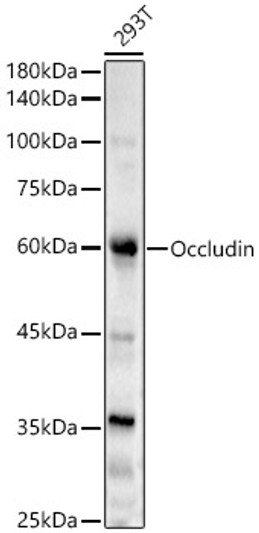| Host: | Rabbit |
| Applications: | WB/IF/ELISA |
| Reactivity: | Human/Mouse/Rat |
| Note: | STRICTLY FOR FURTHER SCIENTIFIC RESEARCH USE ONLY (RUO). MUST NOT TO BE USED IN DIAGNOSTIC OR THERAPEUTIC APPLICATIONS. |
| Short Description : | Rabbit polyclonal antibody anti-Occludin (350-400 aa) is suitable for use in Western Blot, Immunofluorescence and ELISA research applications. |
| Clonality : | Polyclonal |
| Conjugation: | Unconjugated |
| Isotype: | IgG |
| Formulation: | Liquid in PBS containing 50% Glycerol and 0.02% Sodium Azide. |
| Purification: | The antibody was affinity-purified from rabbit antiserum by affinity-chromatography using epitope-specific immunogen. |
| Concentration: | 1 mg/mL |
| Dilution Range: | WB 1:500-2000IF 1:100-300ELISA 1:5000-20000 |
| Storage Instruction: | Store at-20°C for up to 1 year from the date of receipt, and avoid repeat freeze-thaw cycles. |
| Gene Symbol: | OCLN |
| Gene ID: | 100506658 |
| Uniprot ID: | OCLN_HUMAN |
| Immunogen Region: | 350-400 aa |
| Specificity: | OCLN Polyclonal Antibody detects endogenous levels of protein. |
| Immunogen: | Synthesized peptide derived from part of the human protein at the amino acid350-400 |
| Post Translational Modifications | Dephosphorylated by PTPRJ. The tyrosine phosphorylation on Tyr-398 and Tyr-402 reduces its ability to interact with TJP1. Phosphorylation at Ser-490 also attenuates the interaction with TJP1. (Microbial infection) Cleaved by S.pyogenes SpeB protease.leading to its degradation. Degradation by SpeB promotes bacterial translocation across the host epithelial barrier. |
| Function | May play a role in the formation and regulation of the tight junction (TJ) paracellular permeability barrier. It is able to induce adhesion when expressed in cells lacking tight junctions. (Microbial infection) Acts as a coreceptor for hepatitis C virus (HCV) in hepatocytes. |
| Protein Name | Occludin |
| Database Links | Reactome: R-HSA-351906Reactome: R-HSA-8935964 |
| Cellular Localisation | Cell MembraneMulti-Pass Membrane ProteinCell JunctionTight Junction |
| Alternative Antibody Names | Anti-Occludin antibodyAnti-OCLN antibody |
Information sourced from Uniprot.org








